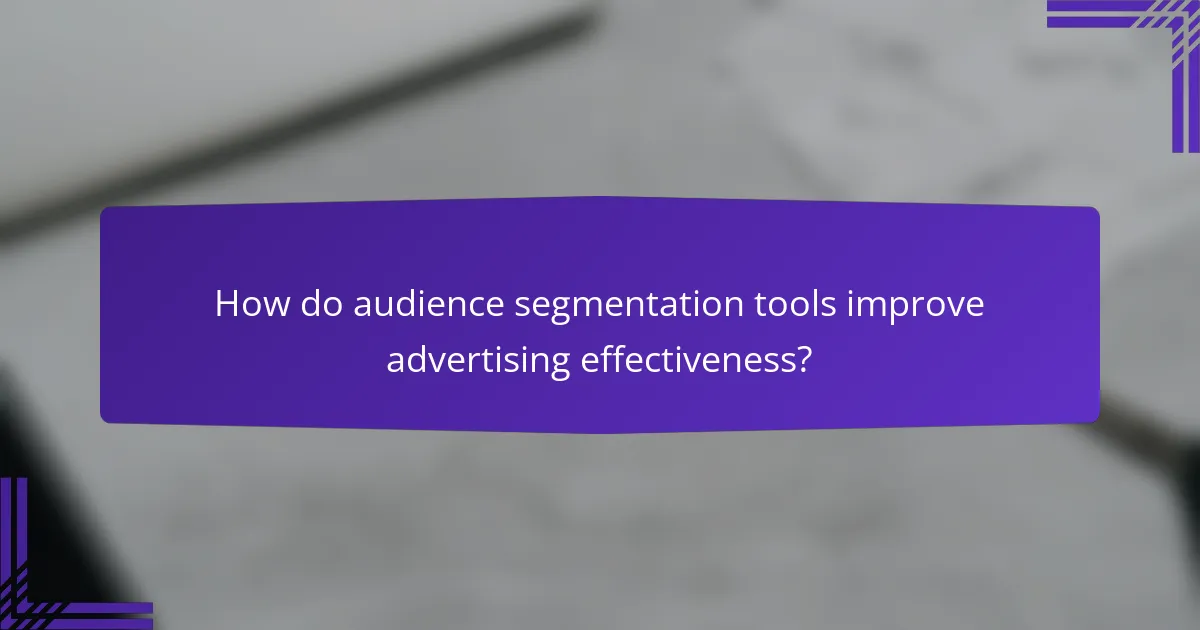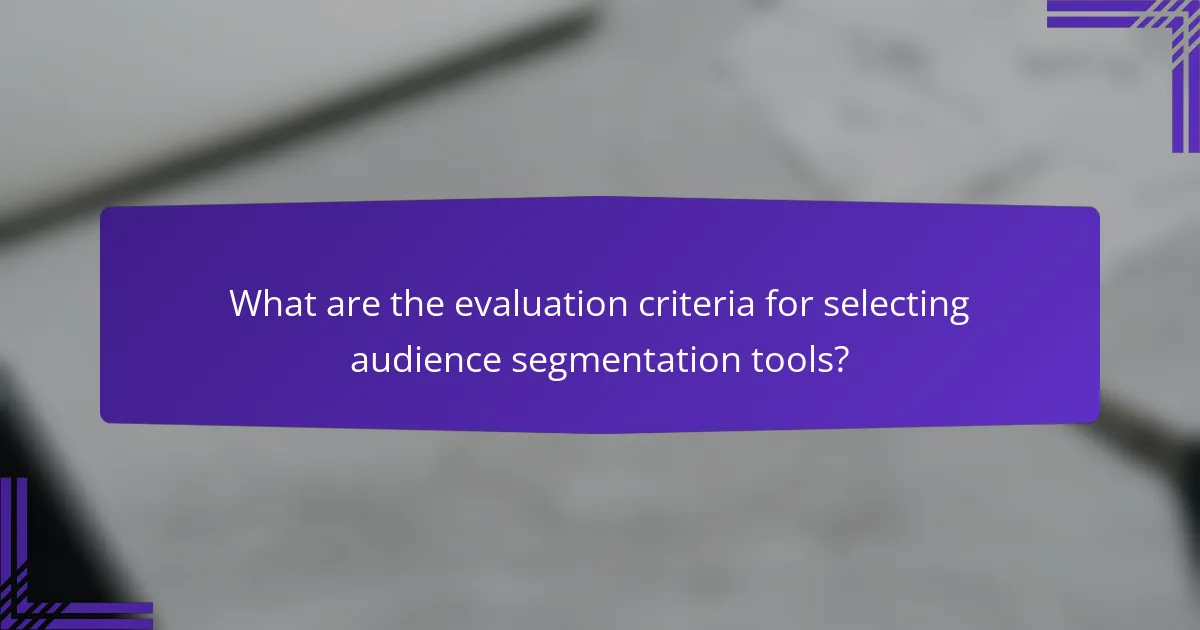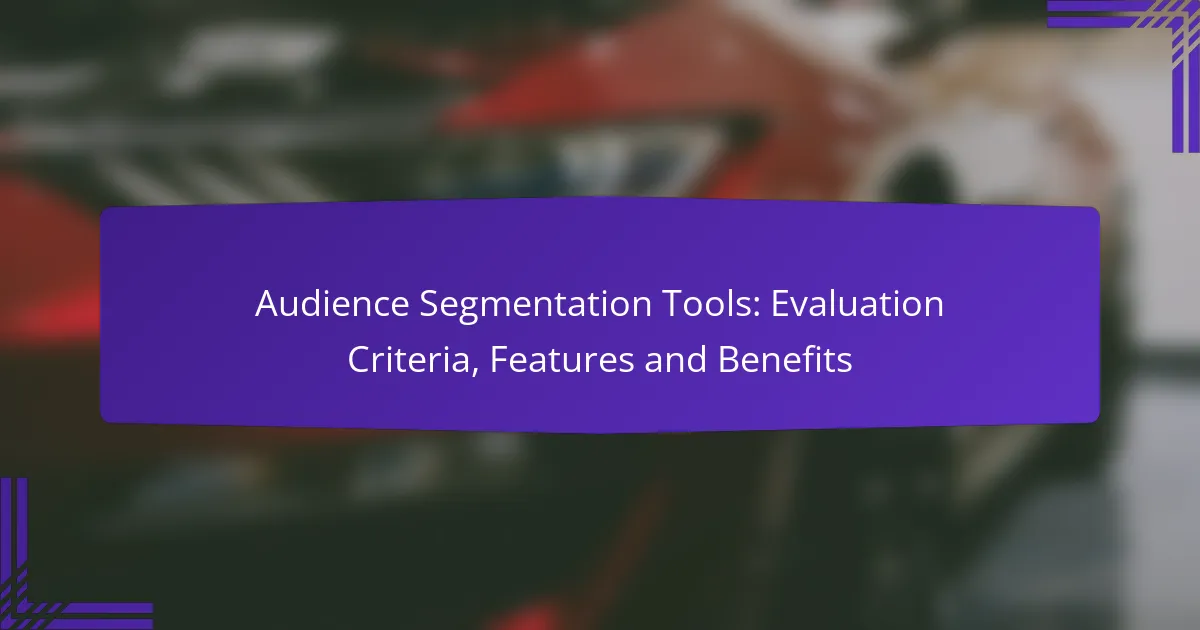Audience segmentation tools are essential for marketers looking to optimize their display advertising efforts in Canada. By enabling the analysis and categorization of audiences, these tools enhance targeting precision, improve ad performance, and ultimately increase return on investment. When selecting a tool, it’s crucial to consider features such as data integration, real-time analytics, and customizable options to effectively tailor campaigns to specific demographics.

What are the best audience segmentation tools for display advertising in Canada?
The best audience segmentation tools for display advertising in Canada include platforms that allow marketers to analyze and categorize their audience effectively. These tools help in targeting specific demographics, enhancing ad performance, and improving return on investment.
Google Analytics 4
Google Analytics 4 (GA4) is a powerful tool for audience segmentation, offering insights into user behavior across websites and apps. It allows marketers to create segments based on user interactions, demographics, and acquisition channels.
To effectively use GA4, set up specific events and conversions that align with your advertising goals. This will help you track the performance of different audience segments and adjust your strategies accordingly.
Segment
Segment is a customer data platform that enables businesses to collect, unify, and activate their audience data. It allows for detailed segmentation based on various attributes, including behavior and demographics.
When using Segment, ensure that your data sources are well integrated to maximize the insights you can gather. This tool is particularly useful for businesses looking to personalize their marketing efforts across multiple channels.
HubSpot
HubSpot offers robust audience segmentation features as part of its marketing automation platform. Users can segment their audience based on lifecycle stages, behaviors, and engagement metrics.
Utilize HubSpot’s workflows to automate targeted campaigns for different segments. This can significantly enhance engagement rates and conversion, especially in the Canadian market where personalized communication is valued.
Mailchimp
Mailchimp is well-known for its email marketing capabilities, but it also provides effective audience segmentation tools. Users can create segments based on subscriber activity, demographics, and purchase history.
To maximize Mailchimp’s segmentation features, regularly update your audience data and utilize A/B testing to determine which segments respond best to different messaging strategies.
Facebook Audience Insights
Facebook Audience Insights is a valuable tool for understanding your audience on social media. It provides demographic information, interests, and behaviors of users interacting with your brand.
Leverage this tool to refine your target audience for display advertising campaigns. By understanding the preferences of your audience, you can create more compelling ads that resonate with Canadian consumers.

How do audience segmentation tools improve advertising effectiveness?
Audience segmentation tools enhance advertising effectiveness by allowing marketers to tailor their campaigns to specific groups, ensuring that messages resonate with the right audience. By analyzing demographic, behavioral, and psychographic data, these tools help in crafting targeted strategies that can significantly boost engagement and conversion rates.
Targeted messaging
Targeted messaging is a key benefit of audience segmentation tools, as they enable advertisers to create personalized content that speaks directly to the needs and preferences of different audience segments. For example, a clothing retailer might segment its audience by age and gender, allowing them to send tailored promotions for women’s fashion to female customers aged 18-30 while offering men’s clothing deals to male customers in a different age range.
To maximize the effectiveness of targeted messaging, marketers should regularly analyze segment performance and adjust their strategies based on engagement metrics. This approach ensures that the messaging remains relevant and compelling to each audience group.
Increased ROI
Using audience segmentation tools can lead to increased return on investment (ROI) by optimizing ad spend and improving conversion rates. By focusing on specific segments that are more likely to convert, advertisers can allocate resources more efficiently, reducing wasted spend on broad, untargeted campaigns.
For instance, a business might find that a particular demographic responds well to email marketing, while another segment engages more through social media. By concentrating efforts on the most profitable channels for each segment, companies can see ROI improvements in the range of 20-50% compared to generic advertising methods.
Enhanced user experience
Audience segmentation tools contribute to an enhanced user experience by delivering relevant content and offers to consumers. When users receive personalized messages that align with their interests and behaviors, they are more likely to engage positively with the brand, leading to higher satisfaction and loyalty.
To create a better user experience, brands should utilize data from segmentation tools to refine their communication strategies. For example, a travel company might segment its audience based on travel preferences, offering tailored vacation packages that cater to adventure seekers versus luxury travelers. This targeted approach not only improves user engagement but also fosters a stronger connection between the brand and its customers.

What features should you look for in audience segmentation tools?
When evaluating audience segmentation tools, prioritize features that enhance data analysis and user experience. Key capabilities include data integration, real-time analytics, a user-friendly interface, and customizable segmentation options that cater to your specific marketing needs.
Data integration capabilities
Data integration is crucial as it allows the audience segmentation tool to pull information from various sources, such as CRM systems, social media platforms, and web analytics. Look for tools that support multiple data formats and APIs to ensure seamless connectivity with existing systems.
Consider tools that can aggregate both structured and unstructured data, enabling a more comprehensive view of your audience. This capability helps in creating more accurate and actionable segments, ultimately improving targeting and campaign effectiveness.
Real-time analytics
Real-time analytics enable marketers to monitor audience behavior and engagement as it happens. This feature allows for timely adjustments to campaigns based on current data trends, enhancing responsiveness and effectiveness.
Choose tools that provide dashboards with live data visualization, making it easier to interpret metrics and make informed decisions quickly. A good real-time analytics feature can significantly improve your ability to react to market changes and audience preferences.
User-friendly interface
A user-friendly interface is essential for ensuring that team members can easily navigate and utilize the tool without extensive training. Look for intuitive designs that allow users to access features and insights with minimal clicks.
Consider tools that offer customizable dashboards and drag-and-drop functionalities, which can simplify the process of segment creation and analysis. A straightforward interface can lead to higher adoption rates among team members and more effective use of the tool’s capabilities.
Customizable segmentation
Customizable segmentation allows marketers to create specific audience groups based on various criteria such as demographics, behavior, and interests. This flexibility is vital for targeting campaigns effectively and maximizing ROI.
Evaluate tools that offer advanced filtering options and the ability to save and reuse segments. This feature can streamline your marketing efforts and ensure that you are consistently reaching the right audience with tailored messages.

What are the benefits of using audience segmentation tools in Canada?
Using audience segmentation tools in Canada allows businesses to tailor their marketing strategies effectively, leading to better-targeted campaigns and improved customer satisfaction. These tools help identify distinct groups within a larger audience, enabling companies to deliver personalized content and offers that resonate with specific demographics.
Improved campaign performance
Audience segmentation tools enhance campaign performance by allowing marketers to focus their efforts on specific groups that are more likely to convert. By analyzing data such as demographics, purchasing behavior, and interests, businesses can craft messages that speak directly to the needs of each segment.
For example, a Canadian retailer might segment their audience based on age and location, creating tailored promotions for younger consumers in urban areas while offering different incentives to older customers in rural regions. This targeted approach can lead to significantly higher conversion rates.
Better customer insights
These tools provide valuable insights into customer preferences and behaviors, helping businesses understand what drives their audience. By leveraging data analytics, companies can identify trends and patterns that inform product development and marketing strategies.
In Canada, understanding cultural nuances and regional differences can be crucial. For instance, a brand might discover that eco-friendly products are particularly appealing to consumers in British Columbia, prompting them to focus their marketing efforts accordingly.
Increased engagement rates
Segmentation leads to increased engagement rates as customers receive content that is relevant to their interests and needs. When businesses tailor their communications, they foster a sense of connection and loyalty among their audience.
For example, a Canadian travel agency could segment their audience by travel preferences, sending personalized offers for adventure trips to thrill-seekers while promoting relaxing beach vacations to families. This level of personalization can significantly boost open and click-through rates in email campaigns.

What are the evaluation criteria for selecting audience segmentation tools?
When selecting audience segmentation tools, consider factors such as usability, integration capabilities, data accuracy, and cost-effectiveness. These criteria help ensure that the tool meets your specific marketing needs and can effectively analyze and segment your audience.
Cost-effectiveness
Cost-effectiveness is a crucial criterion when evaluating audience segmentation tools. It involves assessing the overall value the tool provides relative to its price. Look for tools that offer a balance between features and affordability, ensuring that you get the most out of your investment.
To determine cost-effectiveness, compare pricing models such as subscription fees versus one-time purchases. Many tools offer tiered pricing based on features or user limits, so consider your budget and the scale of your audience segmentation needs. For example, a tool priced at $50 per month may be ideal for small businesses, while larger enterprises might require a more comprehensive solution costing several hundred dollars monthly.
Additionally, factor in potential hidden costs like training, integration, and ongoing support. A tool that appears inexpensive upfront might incur higher costs in the long run if it requires extensive training or lacks customer support. Always evaluate the total cost of ownership to make an informed decision.
